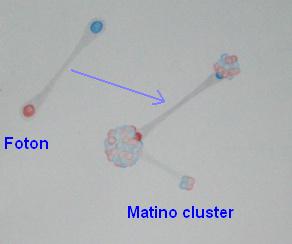Overview

Fotons
The entire universe is made from "fotons".
Free fotons constitute most of the mass of the universe. They are energy.
All matter is made from 'condensed' fotons.

Everything you see is real - it is not an illusion.
What is visible with human eyes is only a small fraction of the universe.
Human eyes can only see the energy released by atoms - visible fotons. We cannot see the sea of fotons and invisible (uncharged) particles enveloping us - which are most of the universe.
Basic properties of the universe
-
There are only 3 physical (geometric) dimensions.
- Time is not a dimension, it is a phenomenon.
- All movement and interactions in the universe behave consistently with classical physics - at all locations, scales and times.
- There is no increase in mass with speed, no time dilation and no speed limit.
- There are only 2 forces in the universe: gravitational force and electrical charge.
- All energy in the universe is kinetic (from movement).
Fotons

The entire universe is made from "fotons".
-
Fotons contain mass - unlike the 'photon' concept.
-
A foton (pron: FOE-ton) is a binary orbiting system consisting of 2 permanently paired, oppositely charged particles. (This idea has been thought of independently by many people at many different times.) They rotate around each other in elliptical (Keplerian) orbits of unlimited size, held together by a bond of gravity and influenced by electromagnetic charge.
- Fotons are the only source of electromagnetism and gravity in the universe.
I assign the name "fotini" (pron: /fo'tini/) to these charged sub-foton particles - "negatini" (pron: /nega'tini/) and "positini" (pron: peoza'tini) to the negative and positive variations. Fotinis cannot occupy the same location at the same time and cannot pass through each other - they have volume and mass. They are not the smallest particle in the universe. The permanent gravitational bond between them does not have mass and transmits forces instantaneously.
Fotinis are the only source of mass and volume in the universe.
Energy and Matter
Free fotons constitute most of the mass of the universe. They are energy.
Their oppositely charged ends allow them to combine together into matter.
All matter is made from 'condensed' fotons.
Fotinis condense into particles in the same way nuclei and electrons combine in metals. The force of electric charge makes this condensation possible. I assign the name 'matino' (pron: /ma'tino/) to these particles of matter. Matinos are liquid-like, they have no solid state. There is two kinds of matter that matinos produce: spirit and atomic matter.

A foton may have both or only one fotini included in a matino. Matinos are interconnected by fotons with one fotini in each of two matinos. The bond between the two fotinis in a foton is gravity and these "bridging" fotons are the only source of gravitational atraction between particles - even between planets and galaxies - bridging fotons can stretch that far. Each matino is connected to many other matinos in this way and this is the basis of the interconnectedness of all things. The electromagnetic charge of fotinis also influences all interactions between fotons and matinos.
Every movement and interaction affects every other part of the universe through a network of bridging fotons and electromagnetic force.
Matinos combine with others in orbits, held together by the gravitational force provided by bridging fotons. Matinos joined together by bridging fotons produce both atomic and non-atomic (spirit) matter.
Matinos combine in orbits to produce all matter, at every scale.
There is no particle other than the matino. All larger forms of matter consist of orbiting systems of matinos. Even planets and galaxies consist entirely of matinos and free fotons.
Spirit matter
Matinos of various sizes with a neutral charge can combine in orbits around each other, held together by gravity. Most of these are quite small, but there are many. They constitute a significant part of the mass of the universe. Having matinos with no charge means this form of matter is invisible to our human eyes.
Atomic matter
Matinos of a particular size and charge combine together to make atoms. It is the atomic arrangement that dictates the size and charge of the matinos that are required for stability. Atoms are not solid particles, but orbiting systems. The matinos in the nucleus orbit around each other, and electrons orbit around the nucleus. Atoms collect together, combine into molecules, which combine into substances. Substances combine into stars and planets, solar systems and galaxies.
All of this made from fotons.
The entire complexity of the universe is the result of two oppositely charged fotinis with mass and volume, permanently paired by gravity, combined with the force of electromagnetism.
The dynamic universe
Rather than being static particles, matinos constantly absorb and emit fotons. While the matino itself appears to be stable, the actual fotons that make up a matino are completely replaced after a period of time. Different situations result in different rates of replacement. The stable size of a matino is totally under the influence of the situation it is in. If the situation changes, so does the stable size. Mass is absorbed or emitted as required.
